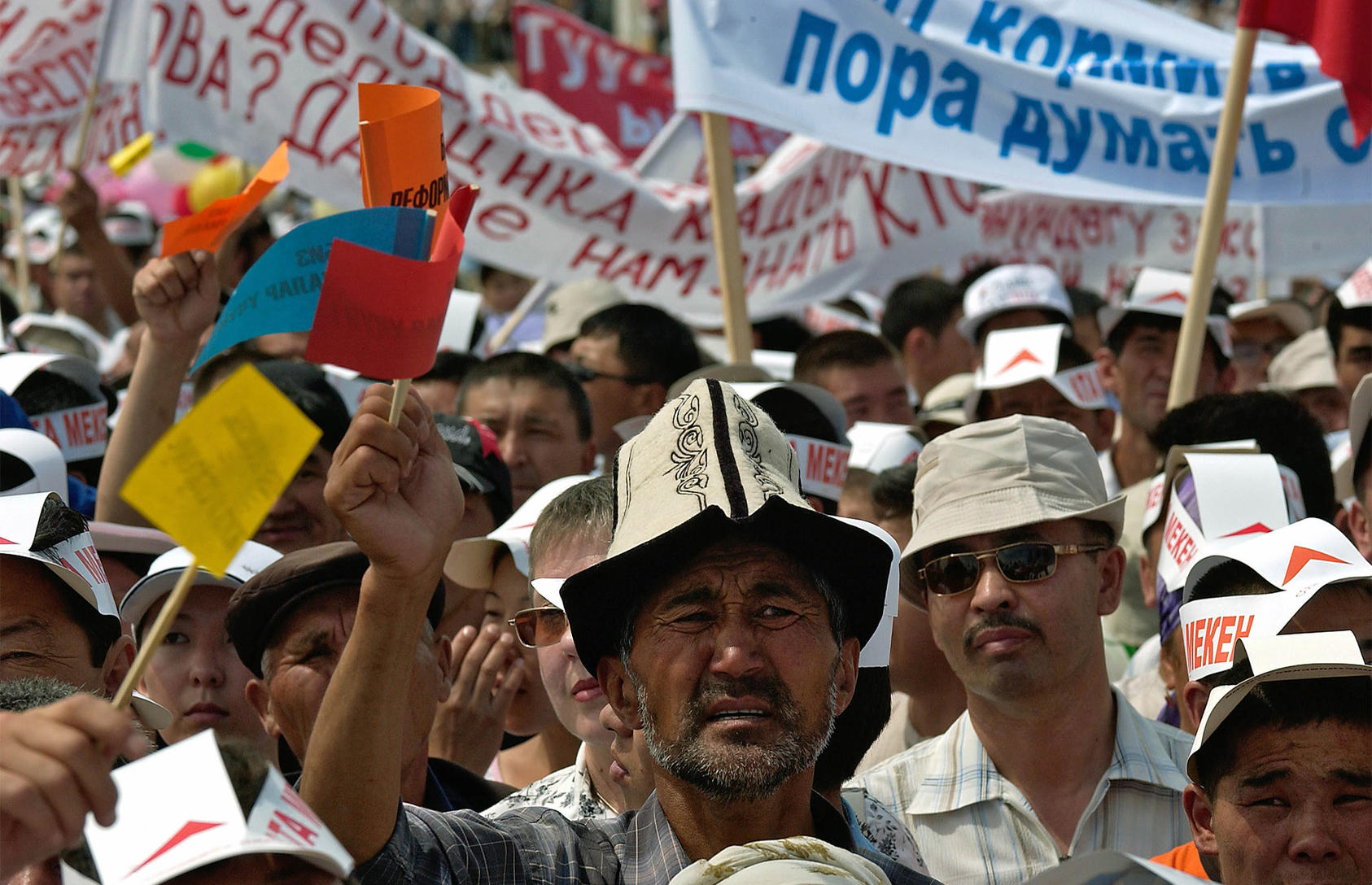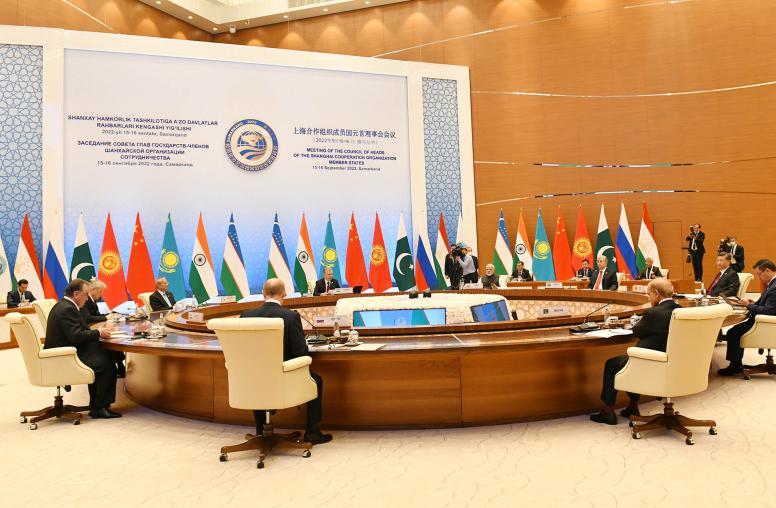In Kyrgyzstan, It’s Easier to Start a Revolution than to Finish It
The country is set to follow a familiar pattern if deep-seated regional and ethnic fault lines are not addressed.
For the third time in 15 years protesters in the Kyrgyz Republic capital of Bishkek have seized and set fire to the “White House,” the seat of parliament and presidential staff. The situation is chaotic with multiple political actors claiming to be in charge and the threat of chaos expanding to the provinces. It is a scene all too familiar to Kyrgyzstan in the last 15 years, leading to a cycle of protests and calls for advancing democracy followed by backsliding into authoritarianism. While working to stabilize the situation in the short term, the United States and regional actors should be cognizant of the country’s deep regional and ethnic fault lines and support actors in Kyrgyzstan who will address them so that this time the cycle does not repeat itself.

A Return to the Past
What’s going on in Kyrgyzstan today has parallels with the last two periods of unrest in the country (2005 and 2010), when revolts over economic issues were coupled with fraudulent parliamentary elections that represented a power grab by forces around the president. In each case, unrest in the capital was accompanied by unrest in key provincial cities and corruption and repressive politics were concentrated in an increasingly authoritarian family in power. Former politicians and government officials who had been discarded, exiled or suppressed by the sitting president quickly climbed on the bandwagon of revolt and positioned themselves for the next regime. In both 2005 and 2010, one of the prominent leaders of the opposition eventually became the new president.
This time around, the economy of Kyrgyzstan is in freefall from a collapse in remittances from labor migrants in Russia caused by COVID-19. In some ways these remittances, which comprise up to a third of the Kyrgyz economy over the last few years, have smoothed the edges of politics in Kyrgyzstan since the 2010 revolt. Kyrgyzstan has long been a place where there is simply not enough butter for everyone’s toast, making it very hard to be a functional democracy and equally hard to hold on to authoritarian power. The failure of the government to adequately respond to the COVID-19 pandemic has also added to the erosion of public trust and the legitimacy of incumbent President Sooronbay Jeenbekov.
As in 2005 and 2010, rotten parliamentary elections that broke a pattern of competitive and somewhat free and fair elections acted as a trigger. In 2020, a brand-new political party Jeenbekov formed merely six months before the election took 25 percent of the vote and another formed by a famously corrupt “businessman” took 23 percent. In addition to outright ballot box stuffing and voter intimidation, there was widespread vote buying and misuse of administrative resources by the pro-government parties. Of the other 14 parties competing, including most of the older established parties, only two managed to break the seven percent threshold for seats in the parliament, giving the pro-establishment parties a supermajority of 107 out of 120 seats. If it were to be seated, this parliament would represent a wholesale conversion to a corrupt, pocket body in which parliamentary immunity for deputies would be the most important thing about membership. Perhaps even more importantly, it would exclude the prominent politicians who have been at the forefront of politics in Kyrgyzstan since independence, creating a huge pool of potential spoilers.
If past patterns hold, we’ll see a great deal of early enthusiasm in both the West and among the politically aware Kyrgyz elites, and then a gradual erosion of democracy caused by the consolidation of an ever-smaller bureaucratic-political elite and the corrosive capture of the political process by business interests and organized criminal interests. Access to and control over sources of wealth will be divvied up among the winners. If things go well economically, this might even last a while until the next economic shock. But this outcome would be no more sustainable than previous attempts to create a functional democracy.
Beyond the Surface: Kyrgyzstan’s Ethnic and Regional Dynamics
But people in Kyrgyzstan don’t primarily recall the stories of the last few decades as a cycle of democratic breakthroughs degrading to authoritarianism. There are other dynamics in play that they are sometimes reluctant to talk about openly or at least with foreigners. Where those of us in the West might see an authoritarian strong man being expelled by a democratic uprising, people in Kyrgyzstan are more likely to see a “southerner” being replaced with a “northerner,” or vice versa. These dynamics—and the deeper cleavages that have undermined Kyrgyzstan’s political evolution—are important to consider when thinking about the threat that this latest revolt might lead to violent conflict.
This botched election led to a situation in which ethnically Kyrgyz politicians from the north were faced with losing badly to the ethnically Kyrgyz southerner Jeenbekov. Protests not only erupted in the capital, but also in the key northern provincial cities of Talas, Naryn, and Karakol. In 2005, it was the other way around; the “northerner” president was undermined by protests in the south. Both authoritarians and democratic coalitions have previously attempted to balance these regional interests across north and south in Kyrgyzstan. This is why civil society and some individuals are now calling on all to avoid “regionalism” and “geographic division.”
Even worse than regionalism, in Kyrgyzstan, nativist ethnic majority politics has been one of the forces unfortunately unleashed by a more open political environment. One of the problems with the choices on the ballot in Kyrgyzstan is that they have generally not given ethnic minorities, especially ethnic Uzbeks, much of an option. Although they comprise nearly 15 percent of the population, Uzbeks are mostly excluded from active political life and subject to economic predation. In 2010, ethnic Uzbeks leaders in the south saw an opportunity in the politically fluid environment to address some of their communal issues and play a role in ejecting the authoritarian president. Some of them acted, along with some Kyrgyz politicians, to help force the local-favorite-son president into exile. Two months later, the former president’s family, perhaps with support from southern politicians and organized criminal groups, provoked mass anti-Uzbek riots around Osh that left at least 420 dead and up to 80,000 displaced, many of whom fled to neighboring Uzbekistan.
Regional Responses
In 2010, Russia was actively agitating against the incumbent president and reluctant to intervene to stop the violence in the south, but was willing to accept an unfamiliar “democratic” interloper among the more authoritarian former Soviet republics as long as Russian economic and foreign policy interests were respected. This time, Russia has called for following the constitution and peaceful resolution of the situation. It is reasonable to assume that they really do want a stable and well-governed neighbor.
Uzbekistan’s President Islam Karimov showed remarkable restraint in 2010 when ethnic Uzbeks from Kyrgyzstan’s southern capital of Osh, which is close enough to the border to see with binoculars, began pouring across the border during anti-Uzbek riots.
It is unclear the role that these and other outside actors will play this time as things develop. Back in 2010, China was still a minor player, but today has more interests and investments in Kyrgyzstan. For its part, the United States should welcome and encourage cooperation by outside actors to reach a peaceful solution.
As of this writing, the situation is a very fluid, but familiar, mess. President Jeenbekov, although in hiding, has not resigned or fled and is proposing talks with all sides. The Central Election Commission has invalidated the results of the parliamentary elections. The outgoing parliament is holding meetings in a hotel and elected both a new speaker and approved as prime minister a politician who was just sprung from a State Security Service prison. Crowds from the street chased the new “prime minster” out the back door soon after.
People are still in the streets in Bishkek and across the north and south of the country. The exiled former strong-man mayor of Osh, who played such a divisive and violent role in 2010, has reemerged there for the crowds. Three different self-organized “Coordination Councils” of political leaders who represent the political parties that failed to reach the threshold in the now invalid election, and forces who could not participate, have set themselves up as interim governments, but are being deemed “unconstitutional” by the new prime minister. They are almost all older ethnically Kyrgyz men.
The hope is that Kyrgyzstan can find something better than the cycle that we’ve already seen play out three times. From the Facebook feeds of former colleagues and friends in Kyrgyzstan I’ve noted a recurrence of this warning: “Whatever kind of government emerges, it won’t do any better if it doesn’t include women, ethnic minorities, youth, and everyone else.”
And so, as in 2005 and 2010, Westerners will tend to watch what’s happening in Kyrgyzstan and see another example of people power versus authoritarianism and corruption, like the recent events in Belarus. Reflecting on the last time this happened in 2010, the United States should:
- Engage more collaboratively with regional powers, especially Russia and China, in providing governance and economic support to Kyrgyzstan’s next reformist government;
- Focus less, or not only, on training on the technical mechanics of democracy, like drafting a constitution or laws, providing advice to the electoral commission or working on judicial management. Much energy and foreign assistance has already been spent on this kind of capacity-building over the years;
- Focus on reforming local politics and decentralization so that minorities, youth, and women have a stake in the system;
- Support local efforts to address discrimination and lack of representation for minorities in policing, the justice system, and the economy;
- Support the next generation of politicians and activists who want to break the old cycle; and
- Support meaningful efforts to examine the difficult history of ethnic relations in Kyrgyzstan and support reconciliation.
These all depend on political will among the politicians who will be in charge in the coming months and years. Without that, no amount of training and capacity-building from abroad can make more than a marginal difference.
Let’s hope the story ends differently this time.



